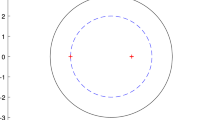Abstract
It is not easy to compute the entanglement of multipartite pure or mixed states, because it usually involves complex optimization. In this paper, we are devoted to the geometric measure of entanglement of multipartite pure or mixed state by the means of real tensor spectrum theory. On the basis of Z-eigenvalue inclusion theorem and the estimation of weakly symmetric nonnegative tensor Z-spectrum radius, we propose some theoretical upper and lower bounds of the geometric measure of entanglement for weakly symmetric pure state with nonnegative amplitudes for two kinds of geometric measures with different definitions, respectively. In addition, the upper bound of the geometric measure of entanglement is also applied to multipartite mixed state case.

Similar content being viewed by others
References
Wei, T.C., Goldbart, P.M.: Geometric measure of entanglement and applications to bipartite and multipartite quantum states. Phys. Rev. A. 68, 042307 (2003)
Hu, S., Qi, L., Zhang, G.: Computing the geometric measure of entanglement of multipartite pure states by means of non-negative tensors. Phys. Rev. A. 93, 012304 (2016)
Shimony, A.: Degree of entanglement. Ann. NY. Acad. Sci. 755, 675 (1995)
Hübener, R., Kleinmann, M., Wei, T.-C., et al.: Geometric measure of entanglement for symmetric states. Phys. Rev. A 80, 032324 (2009)
Qi, L.: Eigenvalues and invariants of tensors. J. Math. Anal. Appl 325, 1363 (2007)
Wei, T.C., Das, D., Mukhopadyay, S., et al.: Global entanglement and quantum criticality in spin chains. Phys. Rev. A 71, 362 (2005)
Yoshifumi, N., Damian, M., Mio, M.: Thermal robustness of multipartite entanglement of the 1-d spin 1/2 xy model. Phys. Rev. A 79, 126 (2009)
Hayashi, M., Markham, D., Murao, M., et al.: The geometric measure of entanglement for a symmetric pure state with non-negative amplitudes. J. Math. Phys 50, 122104 (2009)
Orús, R., Dusuel, S., Vidal, J.: Equivalence of critical scaling laws for many-body entanglement in the lipkin-meshkov-glick model. Phys. Rev. Lett 101, 025701 (2008)
Qiang, W., Zhang, L.: Geometric measure of quantum discord for entanglement of dirac fields in noninertial frames. Phys. Lett. B 742, 383 (2015)
Hilling, J.J., Sudbery, A.: The geometric measure of multipartite entanglement and the singular values of a hypermatrix. J. Math. Phys 51, 072102 (2010)
Che, M., Qi, L., Wei, Y., Zhang, G.: Geometric measures of entanglement in multipartite pure states via complex-valued neural networks. Neurocomputing 313, 25 (2018)
Gour, G., Wallach, N.R.: All maximally entangled four-qubit states. J. Math. Phys 51, 112201 (2010)
Raussendorf, R., Briegel, H.J.: A one-way quantum computer. Phys. Rev. Lett 86, 5188 (2001)
Gross, D., Flammia, S.T., Eisert, J.: Most quantum states are too entangled to be useful as computational resources. Phys. Rev. Lett. 102, 190501 (2009)
Derksen, H., Makam, V.: Highly entangled tensors (2018). arXiv180309788v2
Teng, P.: Accurate calculation of the geometric measure of entanglement for multipartite quantum states. Quntum Inf Process. 16, 181 (2017)
Qi, L., Zhang, G., Ni, G.: How entangled can a multi-party system possibly be? Phys. Lett. A 382, 1465 (2018)
Friedland, S., Kemp, T.: Most boson quantum states are almost maximally entangled. Proc. Am. Math. Soc. 146, 5035 (2018)
Chang, K., Pearson, K., Zhang, T.: Some variational principles for \(Z\)-eigenvalues of nonnegative tensors. Linear Algeb. Appl. 438, 4166 (2013)
Qi, L.: Eigenvalues of a real supersymmetric tensor. J. Symbolic Comput. 40, 1302 (2005)
Hu, S., Huang, Z., Qi, L.: Finding the extreme Z-eigenvalues of tensors via a sequential semidefinite programming method. Numer. Linear Algeb. Appl. 20, 972 (2013)
Chang, K., Qi, L., Zhang, T.: A survey on the spectral theory of nonnegative tensors. Numer. Linear Algeb. Appl. 20, 891 (2013)
Qi, L., Wang, F., Wang, Y.: Z-eigenvalue methods for a global polynomial optimization problem. Math. Progr. 118, 301 (2009)
Chen, L., Han, L., Zhou, L.: Computing tensor eigenvalues via homotopy methods. SIAM J. Matrix Anal. Appl 37, 290 (2016)
Kolda, T.G., Mayo, J.R.: Shifted power method for computing tensor eigenpairs. SIAM J. Matrix Anal. Appl 32, 1095 (2011)
Cui, C., Dai, Y., Nie, J.: All real eigenvalues of symmetric tensors. SIAM J. Matrix Anal. Appl 35, 1582 (2014)
Guo, C., Lin, W., Liu, C.: A modified newton iteration for finding nonnegative Z-eigenpairs of a nonnegative tensor, Numer. Algor., 595 (2019)
Li, W., Liu, D., Vong, S.-W.: Z-eigenpair bounds for an irreducible nonnegative tensor. Linear Algeb. Appl. 483, 182 (2015)
He, J., Huang, T.: Upper bound for the largest Z-eigenvalue of positive tensors. Appl. Math. Lett. 38, 110 (2014)
Chen, L., Han, L., Yin, H., et al.: A homotopy method for computing the largest eigenvalue of an irreducible nonnegative tensor. J. Comput. Appl. Math. 355, 174 (2019)
Kolda, T.G., Mayo, J.R.: An adaptive shifted power method for computing generalized tensor eigenpairs. SIAM J. Matrix Anal. Appl. 35, 1563 (2014)
Ragnarsson, S., Loan, C.F.: Block tensors and symmetric embeddings. Linear Algeb. Appl. 438, 853 (2013)
Wei, T.C., Severini, S.: Matrix permanent and quantum entanglement of permutation invariant states, J. Math. Phys 51 (2010)
Acknowledgements
The authors are grateful to the anonymous referees for their helpful suggestions and comments. This work was supported by the National Natural Science Foundation of China (Grant11971413,11571292) and Science and Technology Foundation of Shenzhen City (No. JCYJ20190808174211224).
Author information
Authors and Affiliations
Corresponding authors
Additional information
Publisher's Note
Springer Nature remains neutral with regard to jurisdictional claims in published maps and institutional affiliations.
Rights and permissions
About this article
Cite this article
Xiong, L., Liu, J. & Qin, Q. The geometric measure of entanglement of multipartite states and the Z-eigenvalue of tensors. Quantum Inf Process 21, 102 (2022). https://doi.org/10.1007/s11128-022-03434-8
Received:
Accepted:
Published:
DOI: https://doi.org/10.1007/s11128-022-03434-8



